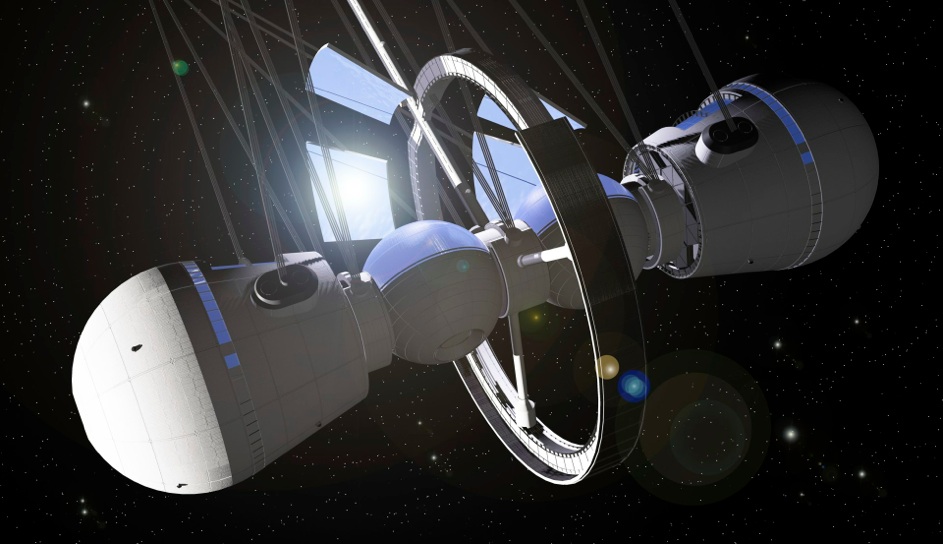Archipel
Prospective of space exploration



Accueil I Prospective I Cartographie I Vaisseaux I Escales I Perspectives I Zooms I Contact I Crédits
© Olivier Boisard - 2006-2013

1 - Main Principles
Building a city ...
The size of Apogeios is modest compared to the first habitat (“Island 1”) described by O'Neill (derived from the Bernal sphere), which itself is very small compared to the cylinders of “Island 3”. This is a real city and not some kind of Resort Park simulating a terrestrial "natural" environment. A smaller size has the advantage of avoiding gigantism that would amplify the difficulties of construction.
Only the initial configuration is defined in this project. Potential for future development should eventually allow residents to develop, transform, or even enlarge their habitat.
... at the Lagrangia point L5 ...
O'Neill's proposal to locate the city on the Lagrangian point L5 of the Earth-Moon system seems appropriate.

For a first "Space Island", this choice seems an acceptable compromise on the following criteria:
• exploit the lunar regolith to produce different metals (mainly aluminum and iron), silicon and oxygen.
• provide regular connections with the Earth, especially during the construction, which will require the transport of persons and specific equipment still manufactured on Earth.
• have a permanent solar flux (ie 1.4 kW/m2) for lighting, electricity generation and heat.
... with extraterrestrial materials ...
Materials used for building Apogeios must be supplied at acceptable technical and economic conditions. Therefore, it is excluded to provide the heavy and voluminous one from the Earth. This implies that even before the beginning of the construction, raw materials are extracted from ore found on celestial bodies with low gravity and orbits located "close" to L5, as the Moon (1/6 g) or asteroids.
The lunar regolith consists mainly of alumina (aluminum for construction), silica (glass and silicon for solar cells), of iron oxide (for steel), rutile and magnesite (titanium and magnesium alloys). Oxygen is used for the atmosphere, industrial processes (steel, welding, etc..) and as a propellant (combustive). However, there is neither carbon nor nitrogen on the Moon, maybe hydrogen, but this not yet evidence of this.
Concerning asteroids, their number and diversity are inexhaustible resources of iron and nickel. Comets could also provide carbonaceous chondrites, water (and hydrogen), nitrogen, carbon, etc.. But if the Moon is relatively well known, this is not the case for asteroids. NEOs (Near Earth Objects) are an interesting category, at least those orbiting relatively close to the Earth.
Ore will be extracted and send to the site of the city. The first step will be to install extraction units, associated equipment (for basic life, energy production, transport, storage and packaging) and transfer systems (mass drivers, bulk carriers , ..). As a guide, it takes 10 T of lunar regolith to produce 1 t of aluminum.
... terrestrial processes ...
Apogeios protects its inhabitants in large pressurized structures covered with a thick layer of protection against ionizing radiation. This means that the walls are those of a battleship. This is not current aerospace industry, especially if we want to use low cost materials, and today’s imperatives for minimizing size and weight of equipment cannot be seen as "design drivers" anymore. Apogeios will be built like large modern ships [4] or terrestrial building, where the economy of construction materials is not the first priority.
The essential problem is to "spatialize" means of production and construction, to suit the very specific conditions of a construction site in space. We believe that architects and construction companies will carry out this transformation, developing skills they already have in some of these domains (lunar concrete, for example).
The construction will require all kinds of materials, components, ingredients, tools and equipment in large quantities. If it is excluded to bring all of them from the Earth, it will be the case at the beginning and later for some specific manufactured goods.
The presence of man will be necessary, to manage and supervise the site. Subsequently, there will be frequent exchanges between the Earth and the city. If we may assume that the return journey is inexpensive, this is not the case for the launch from the Earth : space transportation from the Earth is today 1,000 times more expensive than air travel, and it could remain at a high level in this future.
... solar energy ...
In space, the only two sustainable sources of energy are the Sun and nuclear fission (waiting for fusion). Given the situation of the city, the choice of solar energy makes sense.
Sunlight will be used first to light greenhouses used for food production and regeneration of the atmosphere (biological recycling of CO2 by photosynthesis). But the Sun is also providing heat, directly usable for industrial processes, agricultural greenhouses and air conditioning habitats. We may also, according with O’Neill’s idea, open large windows on certain areas of the habitats, receiving the light of the Sun properly filtered and reflected by mirrors.
For electricity, the photovoltaic conversion is preferable to the thermo-solar power. This was the technical choice for all the satellites until now, and for most of the projects of Solar Power Satellites (SPS).
... and a lot of robots
The transposition in space of terrestrial processes of production, manufacturing and construction, is a real challenge. The experience of Extra-vehicular Activity (EVA) demonstrate the great difficulties for astronauts to perform the simplest operation of assembly / disassembly, the risks and the resulting physical stress. We can hardly imagine to build Apogeios in such conditions! Therefore, we have to use robots, from extraction of minerals and production of materials and fluids, to final assembly, through the development of semi-finished products.
We can imagine a fully automated process for collecting the lunar regolith, transporting, and extracting metals and oxygen. The assembly would be the task of an army of robots, autonomous and versatile enough to cover all the range of operations required. First of them would be sent from the Earth, but a second generation could be manufactured in space.
Pierre Marx & Olivier Boisard
© Olivier Boisard & Pierre Marx - 2011

Habitat
APOGEIOS, a concept of space city
















